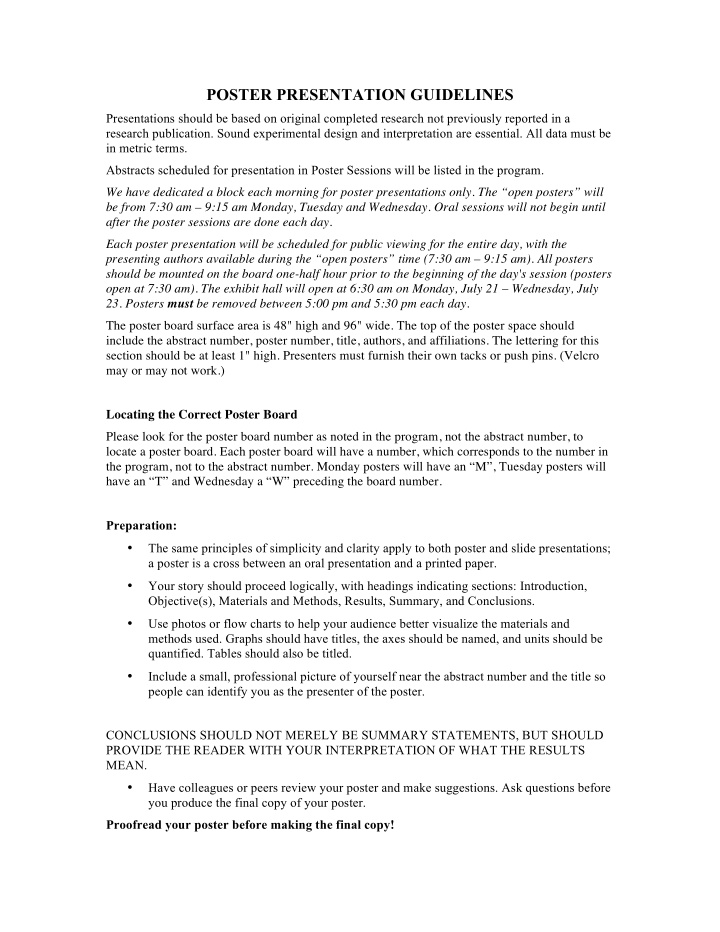



POSTER PRESENTATION GUIDELINES Presentations should be based on original completed research not previously reported in a research publication. Sound experimental design and interpretation are essential. All data must be in metric terms. Abstracts scheduled for presentation in Poster Sessions will be listed in the program. We have dedicated a block each morning for poster presentations only. The “open posters” will be from 7:30 am – 9:15 am Monday, Tuesday and Wednesday. Oral sessions will not begin until after the poster sessions are done each day. Each poster presentation will be scheduled for public viewing for the entire day, with the presenting authors available during the “open posters” time (7:30 am – 9:15 am). All posters should be mounted on the board one-half hour prior to the beginning of the day's session (posters open at 7:30 am). The exhibit hall will open at 6:30 am on Monday, July 21 – Wednesday, July 23. Posters must be removed between 5:00 pm and 5:30 pm each day. The poster board surface area is 48" high and 96" wide. The top of the poster space should include the abstract number, poster number, title, authors, and affiliations. The lettering for this section should be at least 1" high. Presenters must furnish their own tacks or push pins. (Velcro may or may not work.) Locating the Correct Poster Board Please look for the poster board number as noted in the program, not the abstract number, to locate a poster board. Each poster board will have a number, which corresponds to the number in the program, not to the abstract number. Monday posters will have an “M”, Tuesday posters will have an “T” and Wednesday a “W” preceding the board number. Preparation: • The same principles of simplicity and clarity apply to both poster and slide presentations; a poster is a cross between an oral presentation and a printed paper. • Your story should proceed logically, with headings indicating sections: Introduction, Objective(s), Materials and Methods, Results, Summary, and Conclusions. • Use photos or flow charts to help your audience better visualize the materials and methods used. Graphs should have titles, the axes should be named, and units should be quantified. Tables should also be titled. • Include a small, professional picture of yourself near the abstract number and the title so people can identify you as the presenter of the poster. CONCLUSIONS SHOULD NOT MERELY BE SUMMARY STATEMENTS, BUT SHOULD PROVIDE THE READER WITH YOUR INTERPRETATION OF WHAT THE RESULTS MEAN. • Have colleagues or peers review your poster and make suggestions. Ask questions before you produce the final copy of your poster. Proofread your poster before making the final copy!
Characteristics of a Good Poster: 1) Text: • short statements/paragraphs using bullet points • concise lists 2) Color: • text – darker color on white or light-colored paper • matting – darker or subdued colors instead of brilliant colors • colors – limit number used to avoid busyness and distractions. Simple use can add emphasis 3) Text Size: • bold, large, block style; mix capitals and lower case • title legible from 5 to 10 meters • text legible from 1.5 to 2 meters A Sample of Poster Text 4) Layout: • arrange poster sections from top to bottom, starting at the left side • sufficient blank space is important • use spaces to unify/separate sections • avoid too many small sections (poster pieces), too many edges, and too many narrow spaces 5) Illustration: • make graphs and tables as simple as possible; focus on the main ideas • color and size are important • photographs: matte finish is better than glossy; use photos only if they are clear and large enough Presentation: • Set up your poster well in advance of the presentation time. • Arrive promptly for your scheduled presentation time. • If your paper has been published, have extra copies of the paper ready to hand out to those that are interested. Other handouts or summaries are also acceptable, but none are necessary.
Suggestions From Authors Who Have Participated in Poster Sessions • A short and legible “introduction” chart and a “summary of conclusions” chart are helpful to attendees. • Keep text and figure legends short, but do not omit them. • Simple use of color can add emphasis effectively. • Use large print – at least 3/8” high. Shade block letters when possible. • Roll poster materials and insert in a large mailing tube for ease of transportation to the meeting. ¡
Recommend
More recommend